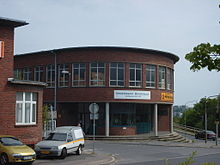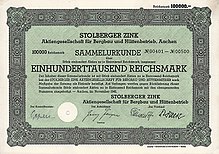Stolberger zinc

The Stolberger Zink AG or Stolberger Zink AG for mining and smelting operations was a mining and metal smelting company in the Aachen district and especially in the Eschweiler-Stolberg area with its headquarters in Stolberg .
history
The original Rheinisch-Nassauische Bergwerks- und Hütten AG was transferred in 1927 to the successor company AG Bergbau, Lead- und Zinkfabrikation zu Stolberg and in Westphalia . In the years 1942/1944, the mines of the AG Mining, Lead and Zinc Production were managed for political reasons under the company name Stolberger Zink AG for mining and smelting . This designation was retained after the Second World War . In 1961/1962, Stolberger Zink AG sold all of its mines to the Wilhelm zu Antweiler union .
From 1935 to 1954, Stolberger Zink operated the Schauinsland mine in Freiburg.
From the beginning of the 1950s to 1968, the Stolberger Zink operated the mine in Maubacher Bleiberg . Furthermore, she held mine ownership or mine shares in Bulgaria ( Bergwerk-AG Pirin ), Spain and Italy . On December 31, 1956, 3900 people were employed.
History without mining operations
In addition to the zinc works in Nievenheim near Dormagen , their main zinc works were the zinc works in Münsterbusch , which was in operation until 1967, and the Binsfeldhammer lead works , which were taken over by the Duisburg company Berzelius Metall in 1970 . Since then she has mainly been in charge of property management, including the sale of commercial space on the recultivated Kohlbusch heap .
A subsidiary was the Silber- und Bleibergwerksgesellschaft AG zu Holzappel in Laurenburg in Rhineland-Palatinate and the Mercur union based in Bad Ems .
Stolberg Society and Metallurgical Society in Stolberg
In 1838 the Metallurgische Gesellschaft zu Stolberg was founded as a corporation by merchants and mine owners. Her main financier was posthumously James Cockerill . It was the first of a long series of metallurgical companies in Stolberg that combined mine ownership and metal smelting. In addition, Cockerill's brother John and Barthold Suermondt from Aachen, Friedrich Thyssen director of the Eschweiler wire factory and the Cologne bank Salomon Oppenheim were also involved.
Her founding assets included the zinc smelter St. Heinrich Münsterbusch , the Galmeigrube Herrenberg , 49/64 shares in the lead and zinc ore mine Diepenlinchen and small shares in the lead and zinc ore mines Breinigerberg and Büsbacherberg . In 1840 the James Pit was taken over by the Metallurgical Society.
In 1841 the Metallurgische Gesellschaft leased all of its operating facilities to the Marquis de Sassenay and became the limited partnership de Sassenay & Cie. converted into the Stolberger Gesellschaft .
In 1845, the transformation of the limited partnership de Sassenay & Cie. in turn the Society for Mining, Lead and Zinc Production zu Stolberg (French: Société anonyme des mines et des fonderies de zinc de Stolberg), briefly called Stolberger Gesellschaft after the Prussian Stock Corporation Act of 1843 was passed.
In 1848, the Stolberger Gesellschaft acquired the lead and silver smelter Münsterbusch, which had been founded two years earlier, from the Aktiengesellschaft zu Bleyberg es Montzen on today's Schellerweg, opposite the Zinkhütter Hof, which was operated until 1916.
Like its two predecessors, the Stolberger Gesellschaft initially covered its zinc and lead ore needs exclusively from Stolberg deposits, above all from the Diepenlinchen ore mine . The merger with the Rheinisch-Westfälischer Bergwerkverein in 1853 brought her access to the rich Ramsbeck lead and zinc ore deposits and a name change to the Society for Mining and Zinc Production in Stolberg and in Westphalia . In 1855 , Wilhelm von der Heydt , who came from an Elberfeld banking family, replaced the Marquis de Sassenay as general director and mastered a crisis in the company. The Stolberger Gesellschaft took over the Büsbacherberg-Brockenberg ore mine from the bankruptcy estate of Allianz . In 1909, the Stolberger Gesellschaft also took over the Emser Blei- und Silberwerk AG .
In 1922, a joint venture was formed with the Eschweiler Gesellschaft , which was merged into the Stolberger Gesellschaft in 1926 on the initiative of the new General Director Hugo Cadenbach . Through this merger, the Good Hope mine near Sankt Goarshausen also came into the possession of the company.
literature
- Gert von Klaß : Stolberger zinc: the history of a metal. Archive for Economics, Darmstadt 1957.
Web links
- The Stolberger Zink AG as reflected in its company names Association for regional technical, economic and social history Histech eV
- Early documents and newspaper articles on Stolberger zinc in the 20th century press kit of the ZBW - Leibniz Information Center for Economics .
Individual evidence
- ^ Herbert Stahl (editor), Gerhard Geurts , Herbert Ommer : Das Erbe des Erzes , Volume 2, The pits on the Gangerz deposits in the ore district of Bensberg. Cologne 2004, ISBN 3-00-014668-7 , p. 178.
- ↑ hasi: Freiburg Ost: Freiburg Kappel: The History. Badische Zeitung, June 1, 2012, accessed on January 10, 2017 .
- ↑ Die Zeit , No. 30, July 25, 1957
- ↑ Wolfgang David: Pit "Consolidated Good Hope" near Wellmich-Werlau. In: Mining in the Rhein-Lahn district. Published by: Rhein-Lahn district administration, 1994.
